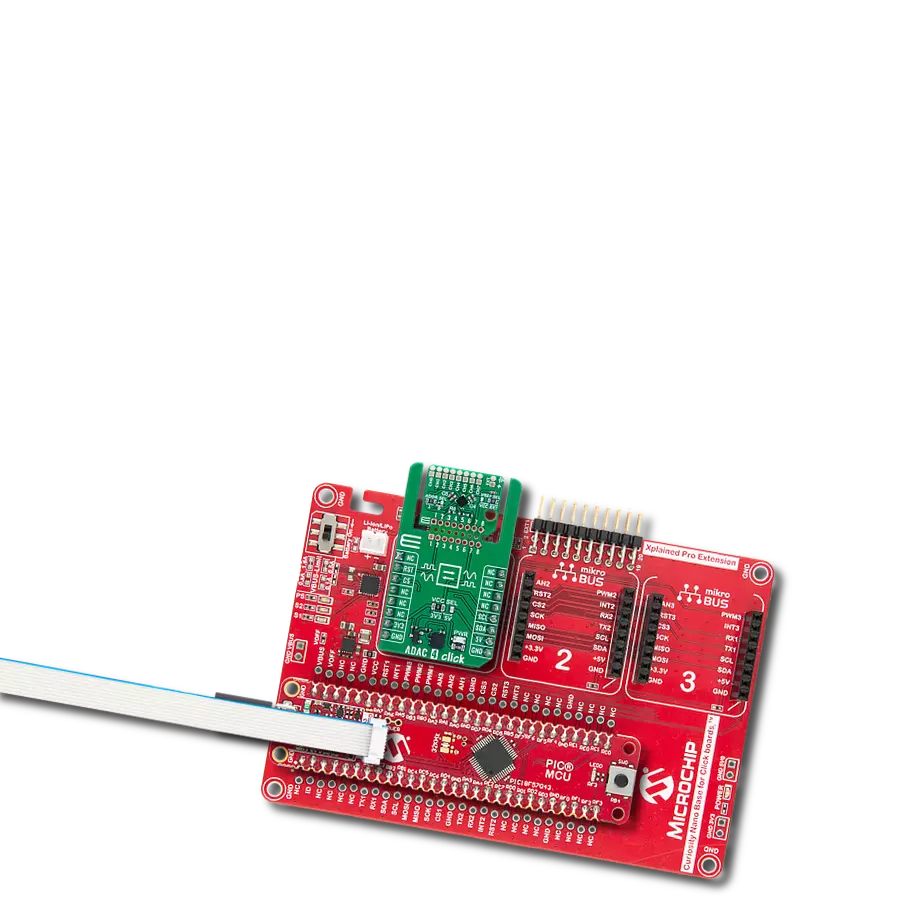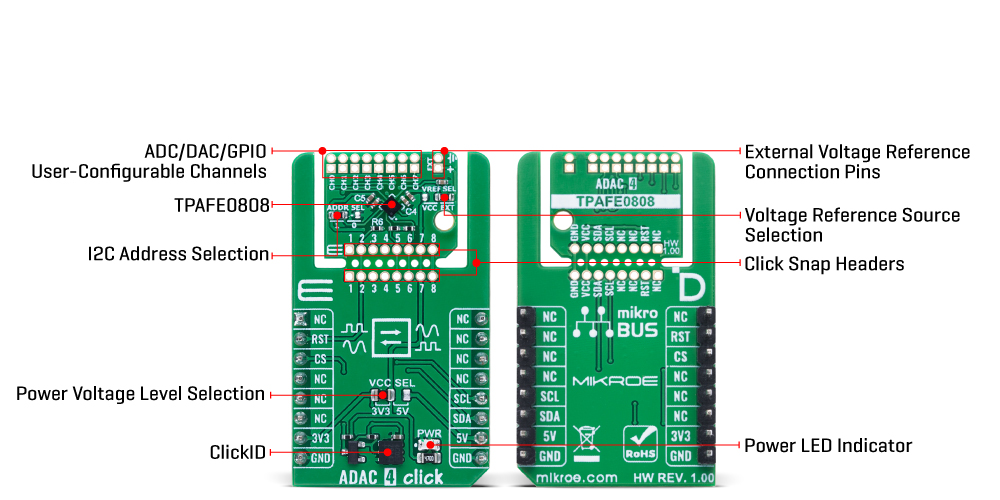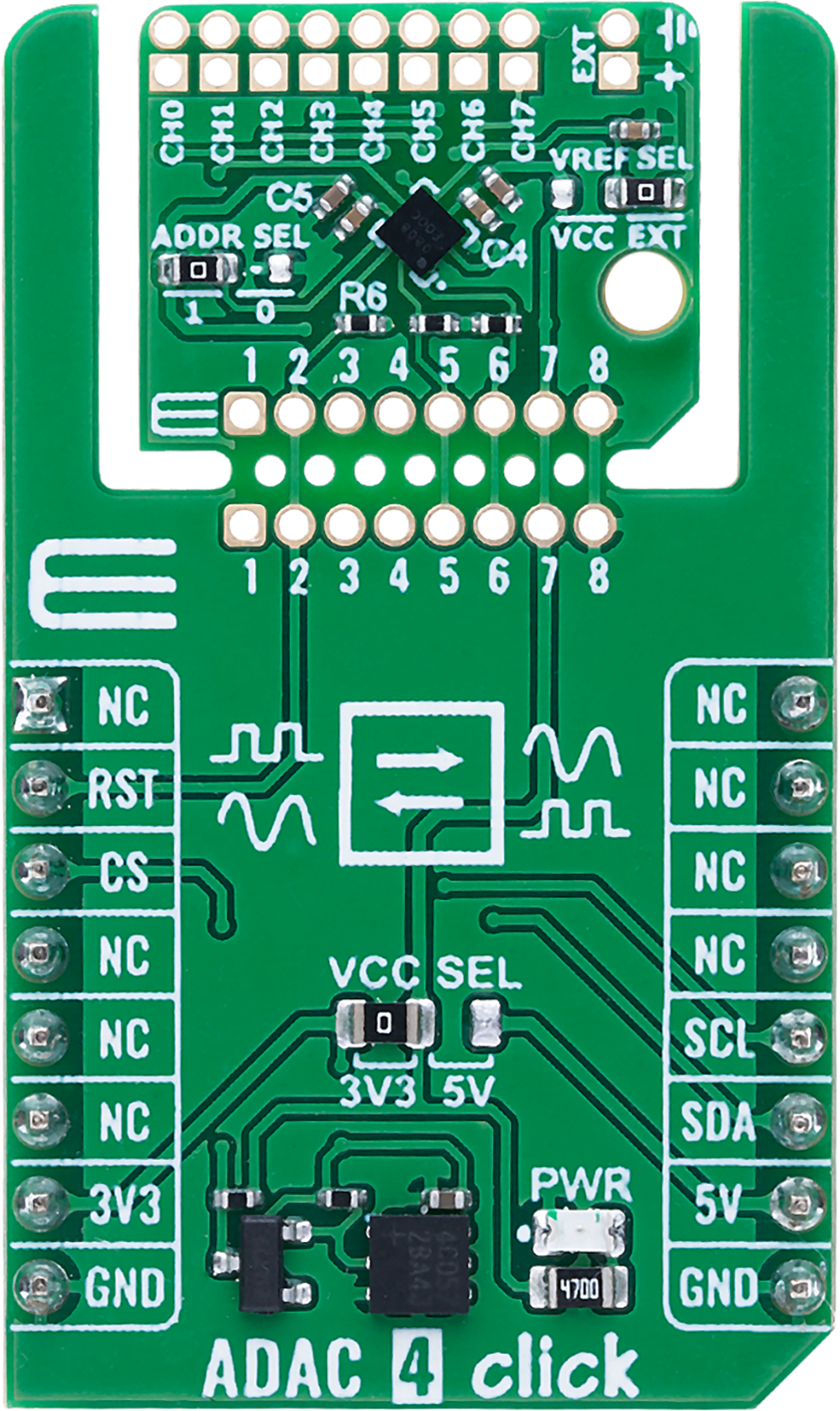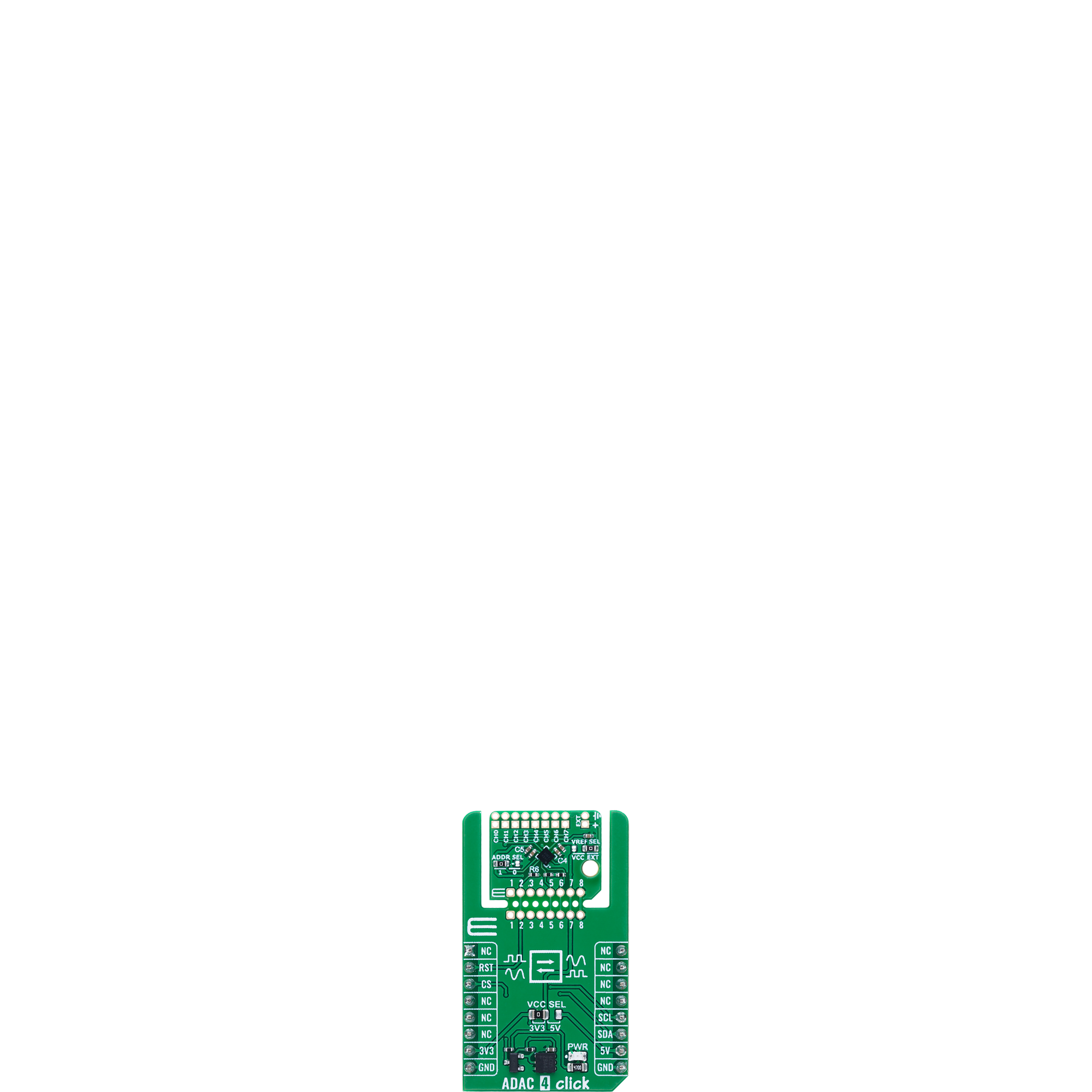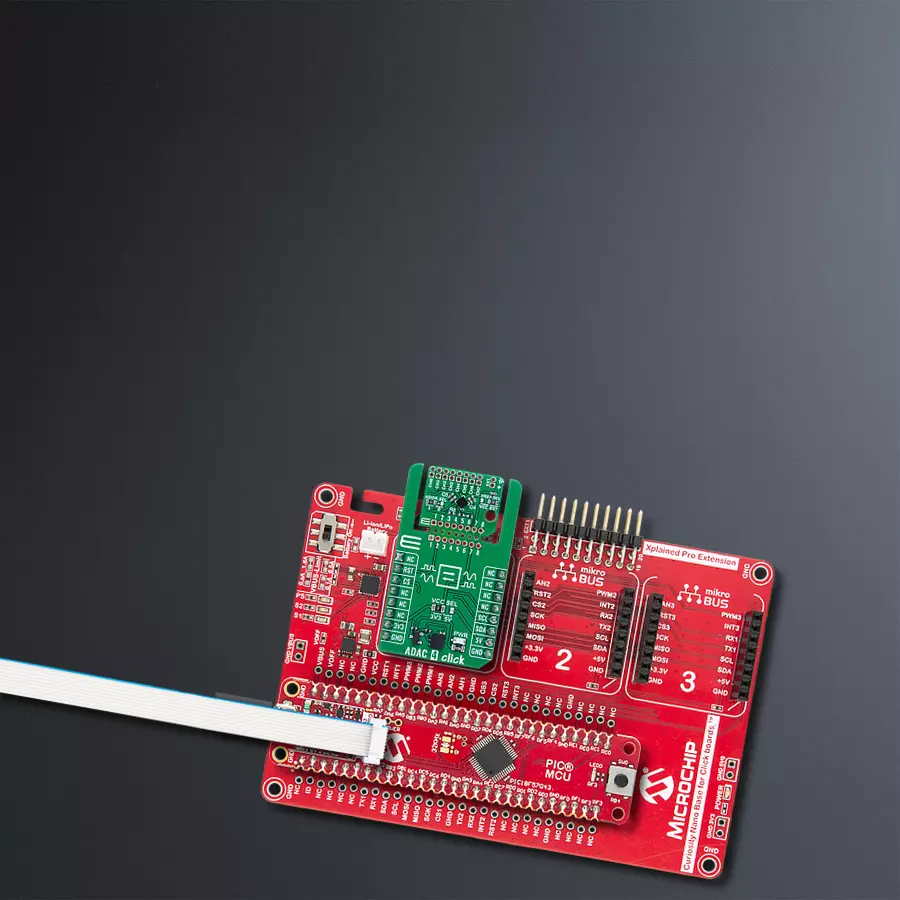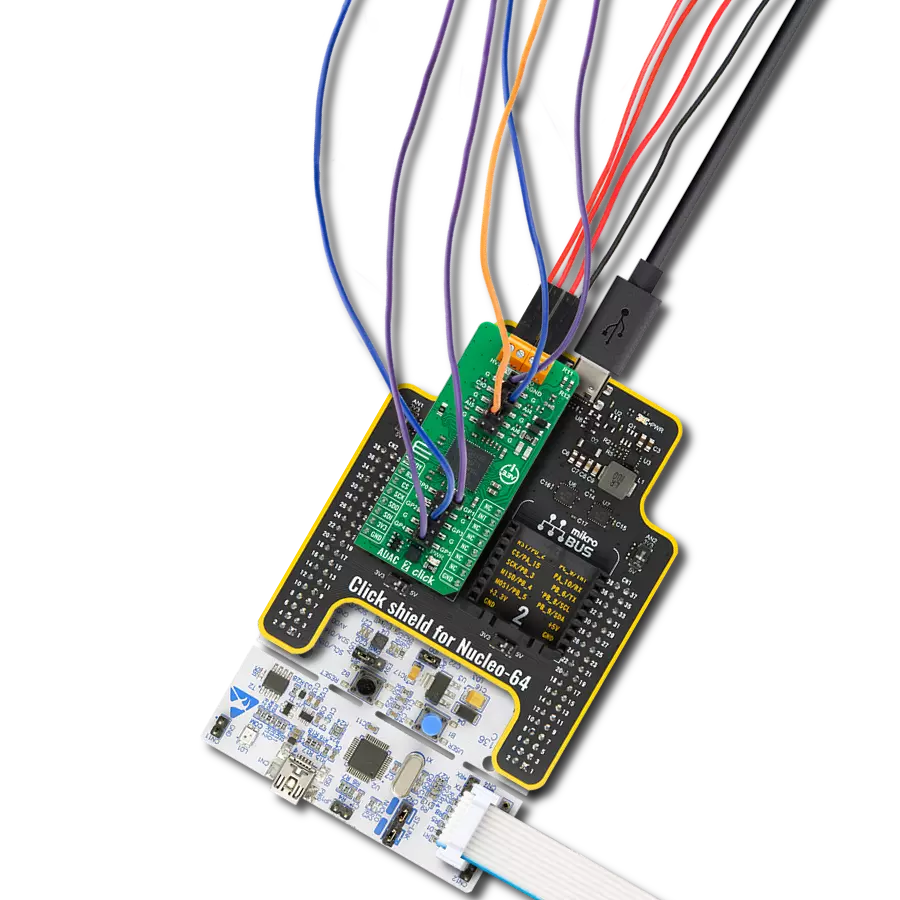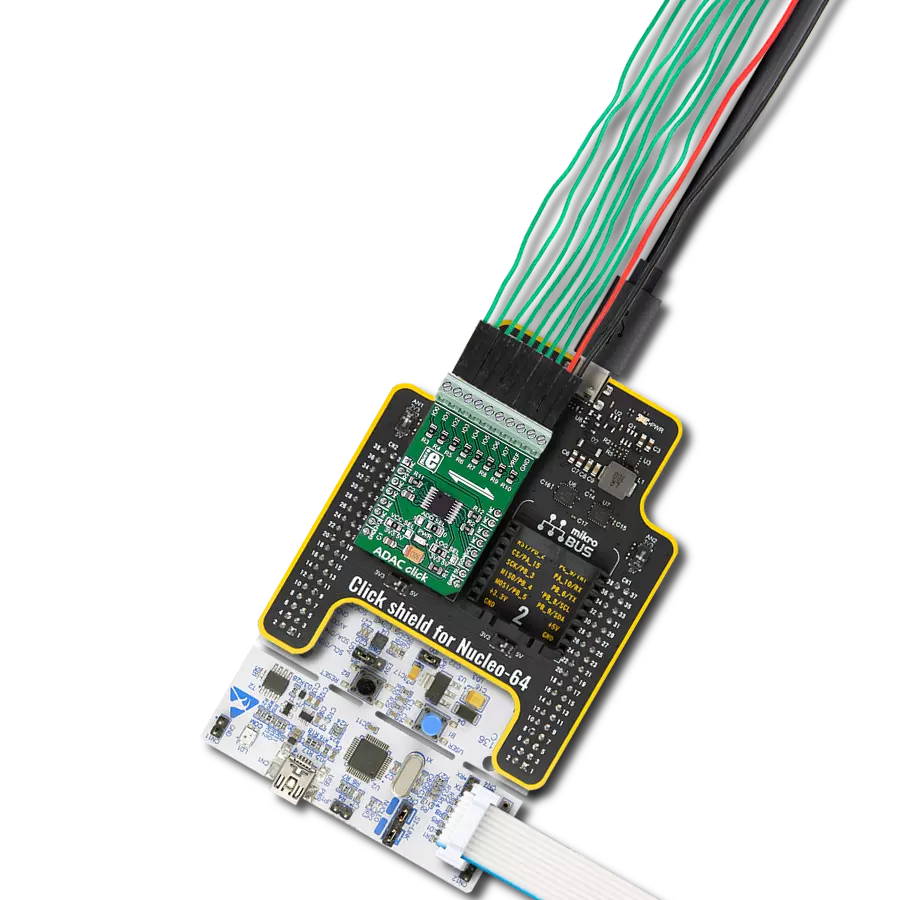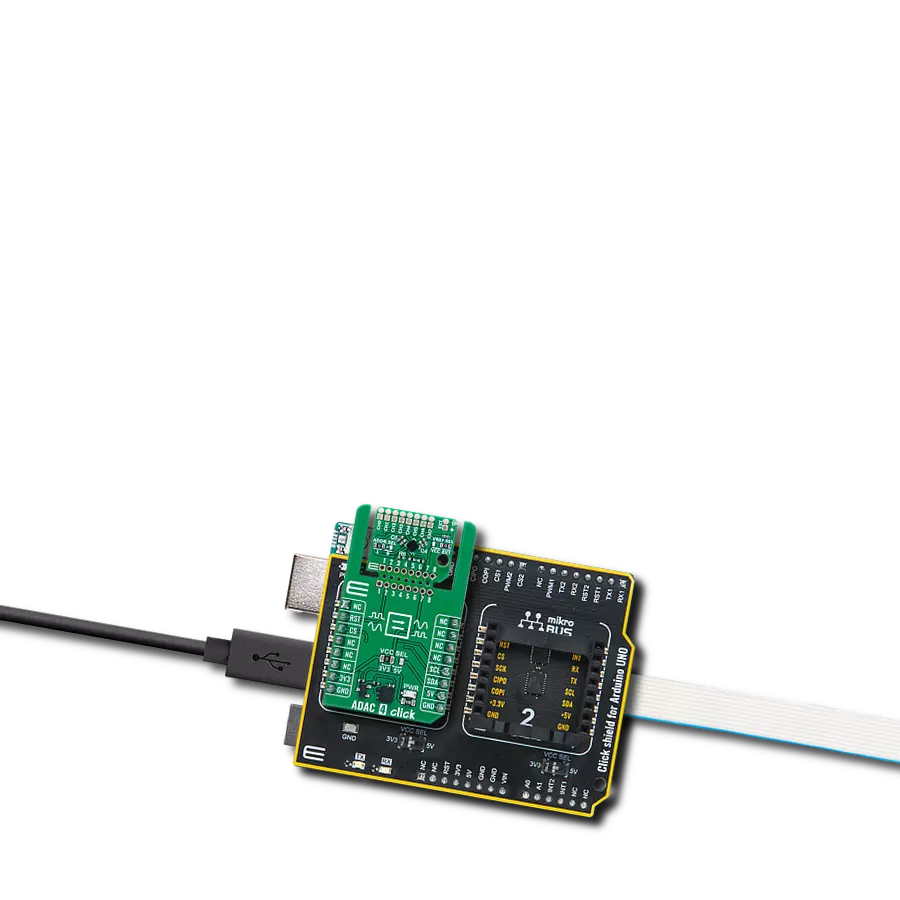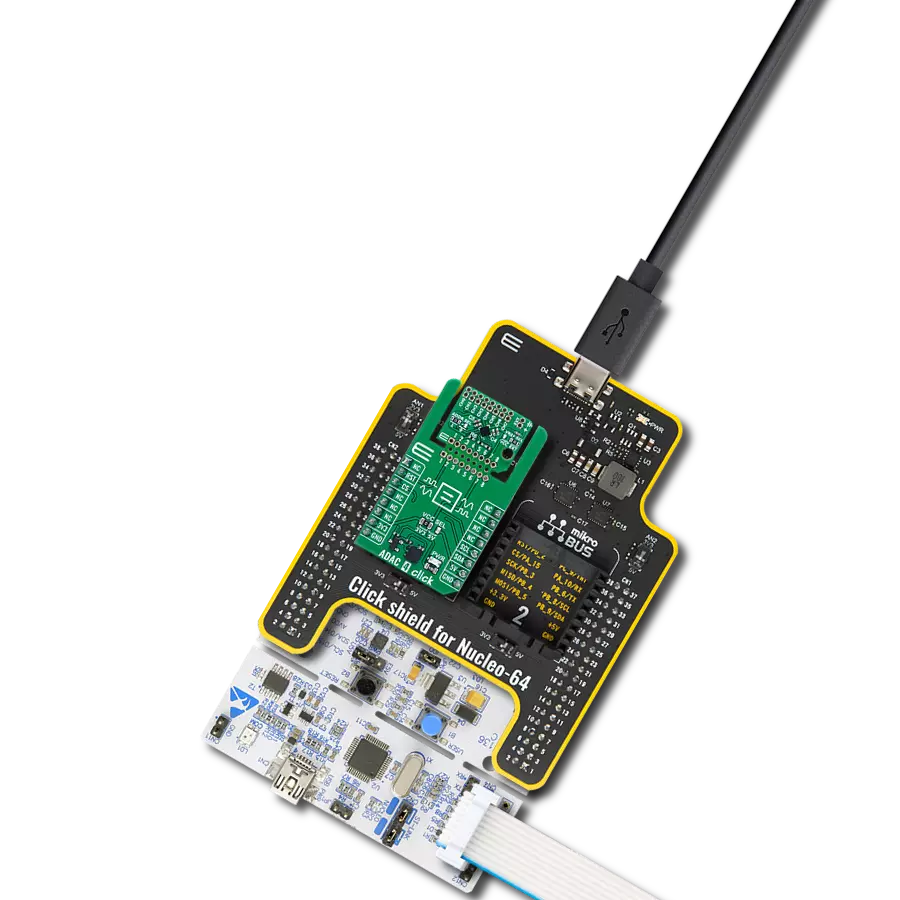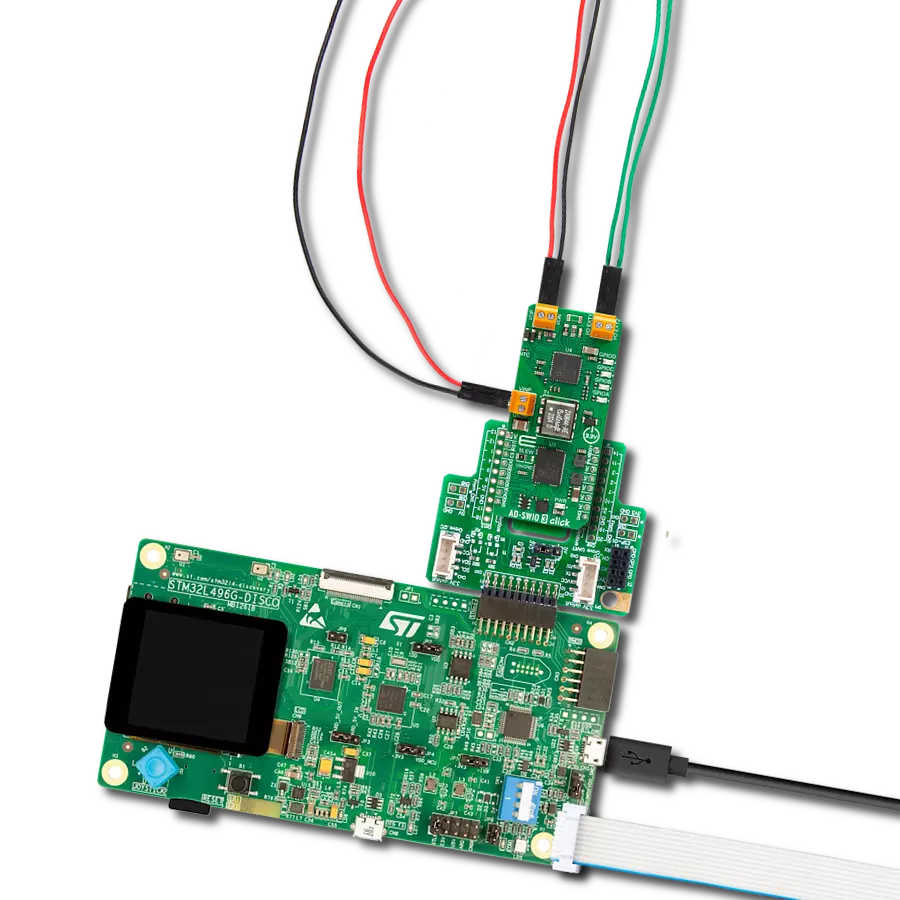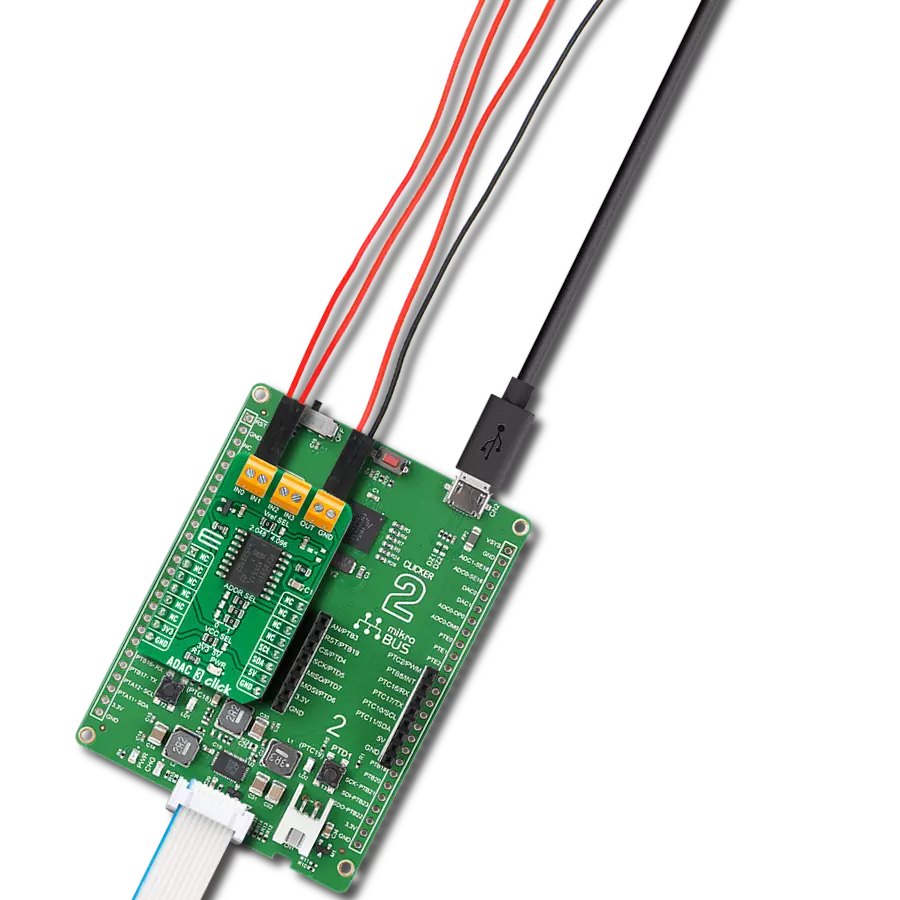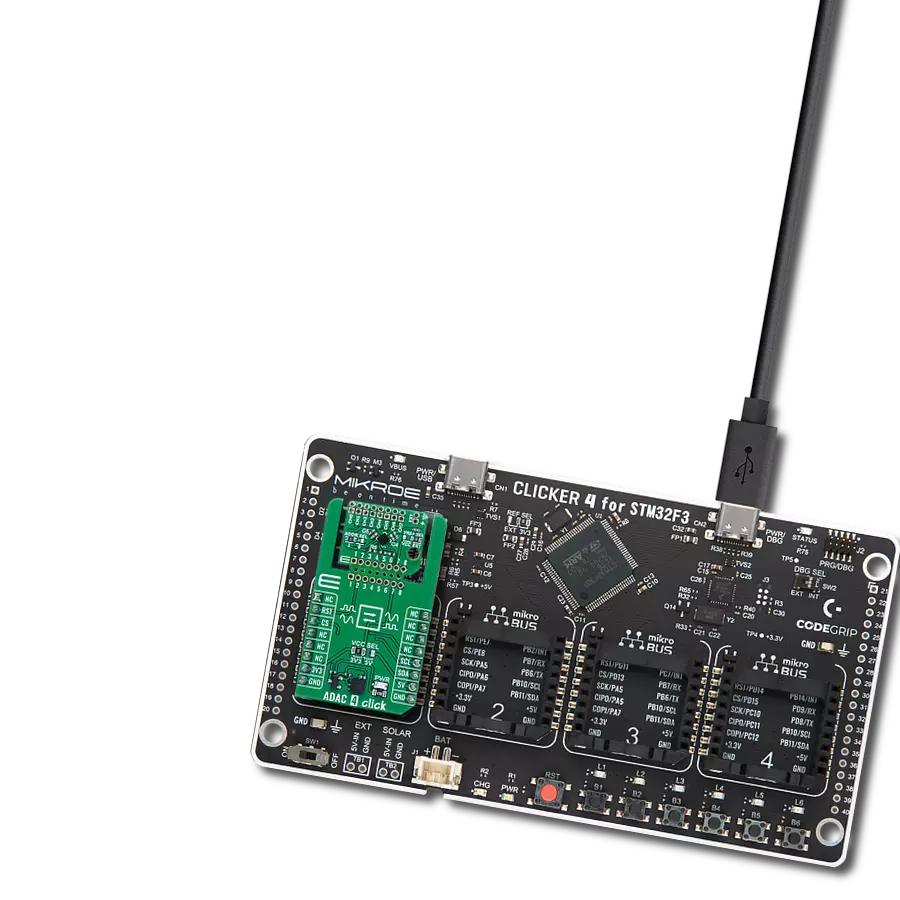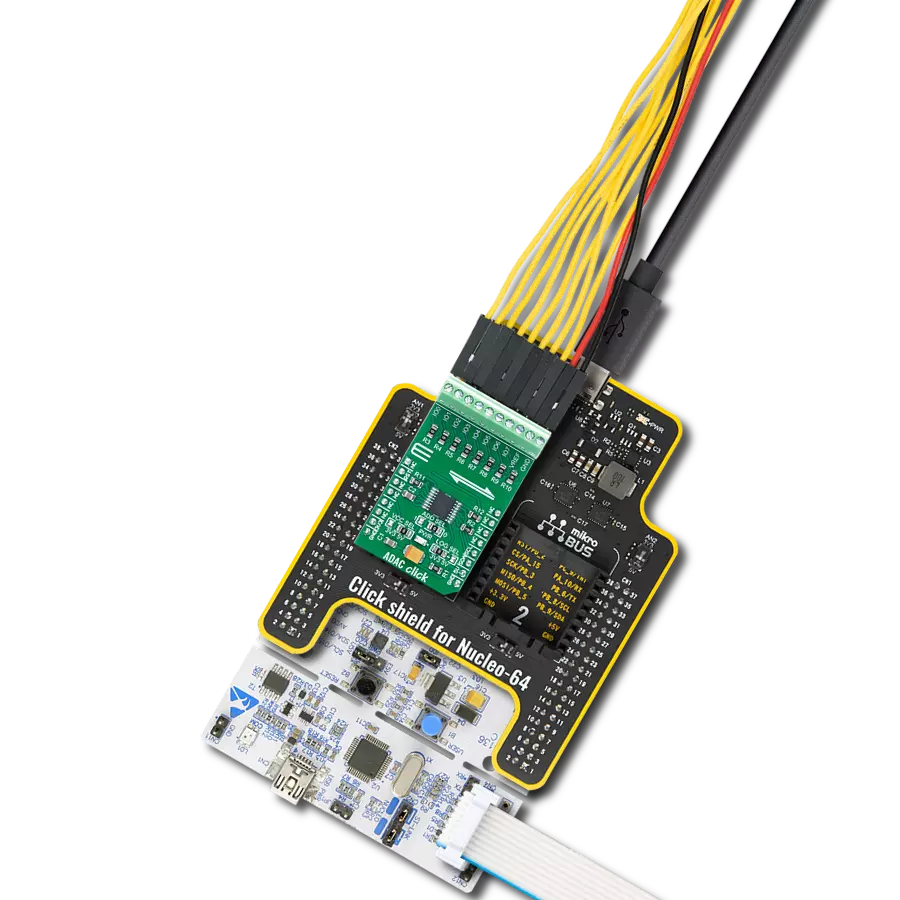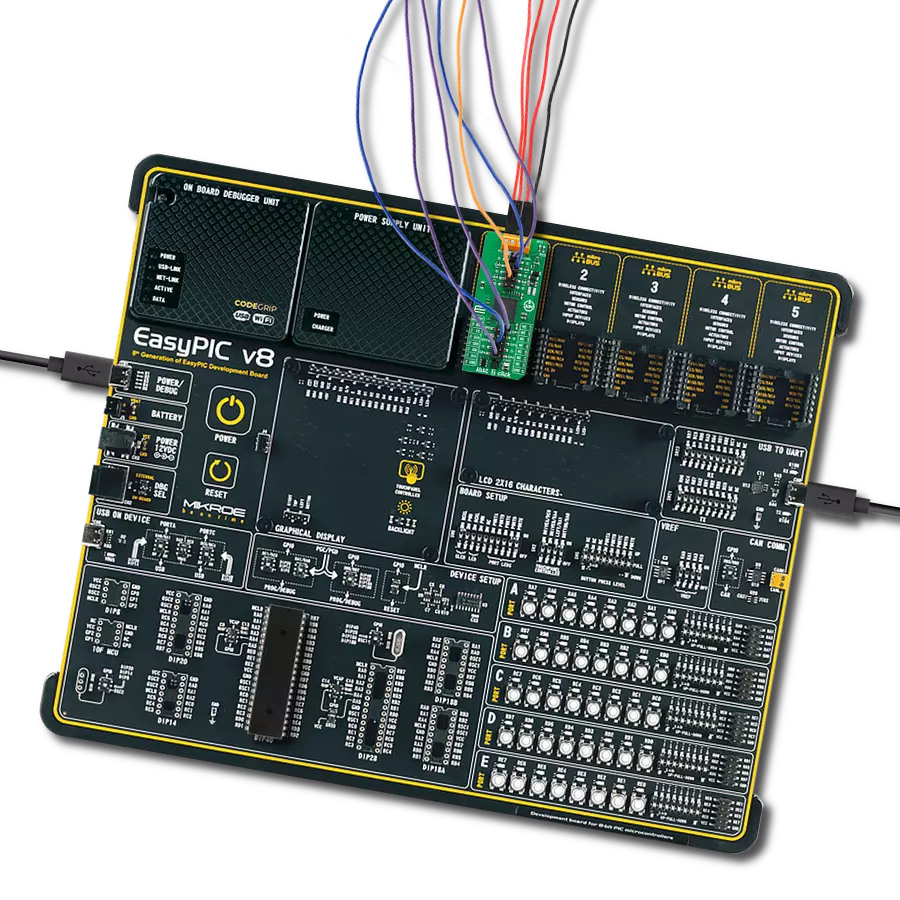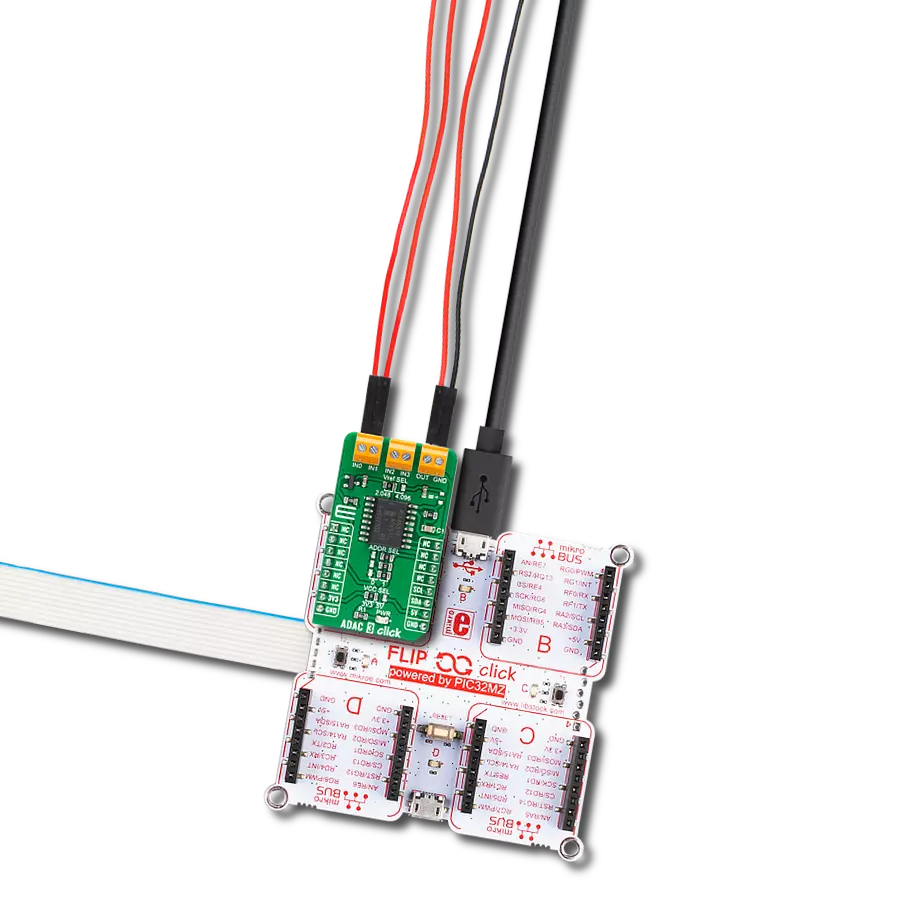Analog and digital I/O expansion with configurable ADC, DAC, and GPIO channels for versatile system control and monitoring
A
A
Hardware Overview
How does it work?
ADAC 4 Click is based on the TPAFE0808, an 8-channel configurable ADC/DAC with I2C communication support from 3PEAK designed to simplify the development of multi-channel analog and digital control systems. Each of the eight channels (CH0–CH7) on the TPAFE0808 can independently function as an ADC input, DAC output, or general-purpose I/O, making the board highly versatile for various control and monitoring applications. Internally, the IC features an integrated 12-bit ADC with an input range selectable between 0–VREF (2.5V) and 0–2×VREF (5V), routed through an 8-channel analog multiplexer that allows sequential or selective sampling. Additionally, a matching 12-bit DAC is provided for each channel, with output voltage ranges configurable to match the same reference-based schemes. The board also includes an internal temperature sensor capable of reading the die temperature with ±3°C accuracy, offering an additional layer of thermal monitoring for embedded
systems. To accommodate different reference voltage requirements, the TPAFE0808 integrated on the ADAC 4 Click includes an internal 2.5V reference and also supports the use of an external reference voltage. When using an external reference, selection is performed via the VREF SEL jumper, which allows the user to choose between sourcing the reference from the mikroBUS™ power rail (VCC) or from an external voltage applied to the unpopulated EXT pin. The VREF SEL jumper is only relevant when the internal reference is disabled. This Click board™ is designed in a unique format supporting the newly introduced MIKROE feature called "Click Snap." Unlike the standardized version of Click boards, this feature allows the main sensor/IC/module area to become movable by breaking the PCB, opening up many new possibilities for implementation. Thanks to the Snap feature, the TPAFE0808 can operate autonomously by accessing its signals directly on the pins marked 1-8. Additionally, the Snap part
includes a specified and fixed screw hole position, enabling users to secure the Snap board in their desired location. This Click board™ uses an I2C interface with clock speeds of up to 400kHz, ensuring fast communication with the host MCU. The I2C address of the TPAFE0808 can be easily configured via onboard jumper marked ADDR SEL in the Snap area, allowing multiple devices to coexist on the same bus. In addition to the interface pins, the ADAC 4 Click also uses the RST pin for resetting the TPAFE0808. This Click board™ can operate with either 3.3V or 5V logic voltage levels selected via the VCC SEL jumper. This way, both 3.3V and 5V capable MCUs can use the communication lines properly. Also, this Click board™ comes equipped with a library containing easy-to-use functions and an example code that can be used as a reference for further development.
Features overview
Development board
PIC18F57Q43 Curiosity Nano evaluation kit is a cutting-edge hardware platform designed to evaluate microcontrollers within the PIC18-Q43 family. Central to its design is the inclusion of the powerful PIC18F57Q43 microcontroller (MCU), offering advanced functionalities and robust performance. Key features of this evaluation kit include a yellow user LED and a responsive
mechanical user switch, providing seamless interaction and testing. The provision for a 32.768kHz crystal footprint ensures precision timing capabilities. With an onboard debugger boasting a green power and status LED, programming and debugging become intuitive and efficient. Further enhancing its utility is the Virtual serial port (CDC) and a debug GPIO channel (DGI
GPIO), offering extensive connectivity options. Powered via USB, this kit boasts an adjustable target voltage feature facilitated by the MIC5353 LDO regulator, ensuring stable operation with an output voltage ranging from 1.8V to 5.1V, with a maximum output current of 500mA, subject to ambient temperature and voltage constraints.
Microcontroller Overview
MCU Card / MCU

Architecture
PIC
MCU Memory (KB)
128
Silicon Vendor
Microchip
Pin count
48
RAM (Bytes)
8196
You complete me!
Accessories
Curiosity Nano Base for Click boards is a versatile hardware extension platform created to streamline the integration between Curiosity Nano kits and extension boards, tailored explicitly for the mikroBUS™-standardized Click boards and Xplained Pro extension boards. This innovative base board (shield) offers seamless connectivity and expansion possibilities, simplifying experimentation and development. Key features include USB power compatibility from the Curiosity Nano kit, alongside an alternative external power input option for enhanced flexibility. The onboard Li-Ion/LiPo charger and management circuit ensure smooth operation for battery-powered applications, simplifying usage and management. Moreover, the base incorporates a fixed 3.3V PSU dedicated to target and mikroBUS™ power rails, alongside a fixed 5.0V boost converter catering to 5V power rails of mikroBUS™ sockets, providing stable power delivery for various connected devices.
Used MCU Pins
mikroBUS™ mapper
Take a closer look
Click board™ Schematic
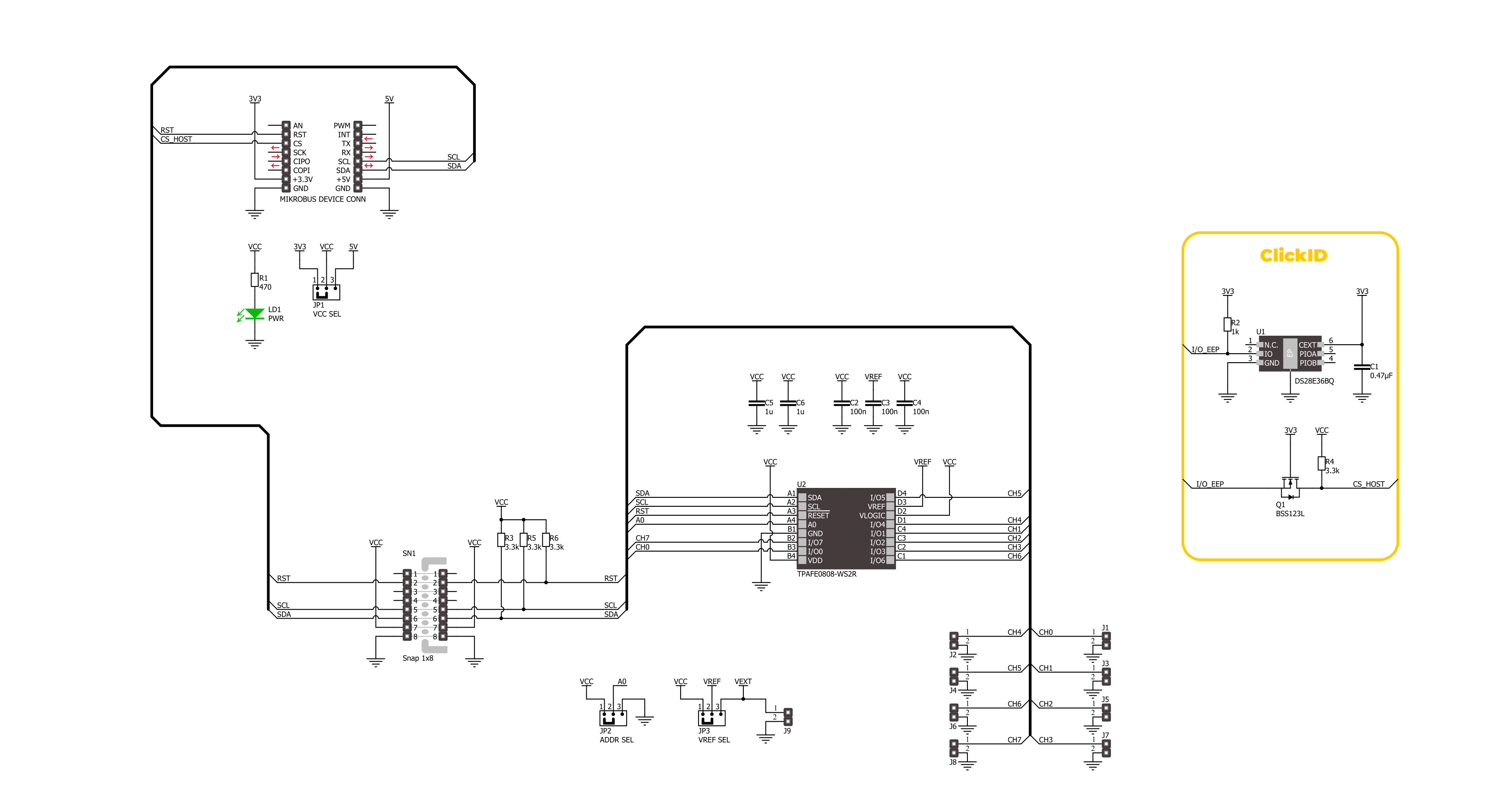
Step by step
Project assembly
Software Support
Library Description
ADAC 4 Click demo application is developed using the NECTO Studio, ensuring compatibility with mikroSDK's open-source libraries and tools. Designed for plug-and-play implementation and testing, the demo is fully compatible with all development, starter, and mikromedia boards featuring a mikroBUS™ socket.
Example Description
This example demonstrates the use of the ADAC 4 Click board which features an 8-channel, 12-bit DAC and ADC. The application configures each DAC channel with incremental values and measures the corresponding output voltage using the integrated ADC, as well as logs the device die temperature.
Key functions:
adac4_cfg_setup- This function initializes Click configuration structure to initial values.adac4_init- This function initializes all necessary pins and peripherals used for this Click board.adac4_default_cfg- This function executes a default configuration of ADAC 4 Click board.adac4_write_dac- This function writes a value to the specified DAC channel.adac4_read_adc_voltage- This function reads an ADC voltage value from the specified channel.adac4_read_die_temp- This function reads and calculates internal die temperature.
Application Init
Initializes the logger and the Click board driver, and applies the default configuration.
Application Task
Iterates through all 8 DAC/ADC channels, sets an output voltage, reads back the corresponding ADC voltage, and logs both values. Also reads and logs the die temperature.
Open Source
Code example
The complete application code and a ready-to-use project are available through the NECTO Studio Package Manager for direct installation in the NECTO Studio. The application code can also be found on the MIKROE GitHub account.
/*!
* @file main.c
* @brief ADAC 4 Click example
*
* # Description
* This example demonstrates the use of the ADAC 4 Click board which features
* an 8-channel, 12-bit DAC and ADC. The application configures each DAC channel
* with incremental values and measures the corresponding output voltage using
* the integrated ADC, as well as logs the device die temperature.
*
* The demo application is composed of two sections :
*
* ## Application Init
* Initializes the logger and the Click board driver, and applies the default configuration.
*
* ## Application Task
* Iterates through all 8 DAC/ADC channels, sets an output voltage, reads back the
* corresponding ADC voltage, and logs both values. Also reads and logs the die temperature.
*
* @author Stefan Filipovic
*
*/
#include "board.h"
#include "log.h"
#include "adac4.h"
static adac4_t adac4;
static log_t logger;
void application_init ( void )
{
log_cfg_t log_cfg; /**< Logger config object. */
adac4_cfg_t adac4_cfg; /**< Click config object. */
/**
* Logger initialization.
* Default baud rate: 115200
* Default log level: LOG_LEVEL_DEBUG
* @note If USB_UART_RX and USB_UART_TX
* are defined as HAL_PIN_NC, you will
* need to define them manually for log to work.
* See @b LOG_MAP_USB_UART macro definition for detailed explanation.
*/
LOG_MAP_USB_UART( log_cfg );
log_init( &logger, &log_cfg );
log_info( &logger, " Application Init " );
// Click initialization.
adac4_cfg_setup( &adac4_cfg );
ADAC4_MAP_MIKROBUS( adac4_cfg, MIKROBUS_1 );
if ( I2C_MASTER_ERROR == adac4_init( &adac4, &adac4_cfg ) )
{
log_error( &logger, " Communication init." );
for ( ; ; );
}
if ( ADAC4_ERROR == adac4_default_cfg ( &adac4 ) )
{
log_error( &logger, " Default configuration." );
for ( ; ; );
}
log_info( &logger, " Application Task " );
}
void application_task ( void )
{
static uint16_t dac_data = ADAC4_DAC_DATA_MIN;
float die_temp = 0;
float voltage = 0;
for ( uint8_t ch_sel = ADAC4_CHANNEL_0; ch_sel <= ADAC4_CHANNEL_7; ch_sel++ )
{
log_printf ( &logger, "\r\n CH%u -> ", ( uint16_t ) ch_sel, dac_data );
if ( ADAC4_OK == adac4_write_dac ( &adac4, ch_sel, dac_data ) )
{
log_printf ( &logger, "DAC: %.4u, ", dac_data );
}
if ( ADAC4_OK == adac4_read_adc_voltage ( &adac4, ch_sel, &voltage ) )
{
log_printf ( &logger, "Voltage: %.3f", voltage );
}
dac_data += 200;
if ( dac_data > ADAC4_DAC_DATA_MAX )
{
dac_data = ADAC4_DAC_DATA_MIN;
}
}
if ( ADAC4_OK == adac4_read_die_temp ( &adac4, &die_temp ) )
{
log_printf ( &logger, "\r\n Die Temperature: %.2f degC\r\n", die_temp );
}
Delay_ms ( 1000 );
Delay_ms ( 1000 );
Delay_ms ( 1000 );
}
int main ( void )
{
/* Do not remove this line or clock might not be set correctly. */
#ifdef PREINIT_SUPPORTED
preinit();
#endif
application_init( );
for ( ; ; )
{
application_task( );
}
return 0;
}
// ------------------------------------------------------------------------ END
Additional Support
Resources
Category:ADC-DAC
